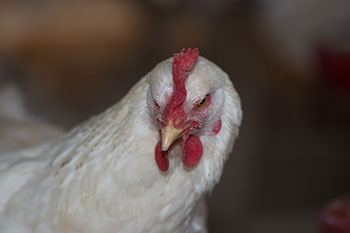Information about Psittacosis for Employers and Employees at Poultry Slaughter Plants
- Workers should contact a healthcare professional if you have fever, cough, headache, or muscle aches after working at a poultry slaughter plant. If you have psittacosis, healthcare professionals can treat it with antibiotics.
- Plant management should implement steps to minimize exposures to bird droppings and respiratory secretions to protect their workers.
- Learn how people who work in poultry slaughter plants can prevent psittacosis.

The Virginia and Georgia departments of health investigated a multistate outbreak of psittacosis. This outbreak occurred at poultry slaughter plants owned by a single corporation. CDC and the U.S. Department of Agriculture assisted with the investigation. Learn more about this outbreak.
Bacteria called Chlamydia psittaci often infect birds. Less commonly, these bacteria can infect people and cause a disease called psittacosis. Generally, psittacosis causes mild illness, but it can also cause pneumonia (a lung infection). Rarely, psittacosis can be deadly.
How Psittacosis Spreads
The bacteria can infect people who are exposed to infected birds. It is important to know that infected birds do not always have symptoms or seem sick. Both sick birds and birds without symptoms shed the bacteria in their droppings and respiratory secretions. When these secretions dry, small dust particles (including the bacteria) can get into the air. The most common way someone gets infected is by breathing in the dust from these dried secretions. Less commonly, birds infect people through bites and beak-to-mouth contact.
In general, people do not spread psittacosis to other people. However, this is possible in rare cases. There is no evidence that the bacteria spread by preparing or eating chicken meat.
People at Increased Risk
A small number of psittacosis outbreaks have occurred in plants that process or slaughter turkeys, ducks, or chickens.
In psittacosis outbreaks among poultry plant workers, those who have contact with live birds (e.g., receiving, live hanging, slaughtering) or with the internal organs of birds (evisceration) are at greatest risk for disease. However, workers performing other duties with poultry contact (e.g., deboning, cutting) or with sanitation, maintenance, or administrative duties are also at risk.
People of all ages can get psittacosis, but it is more commonly reported among adults. Those who have contact with pet birds and poultry, including people who work in bird-related occupations, are at increased risk:
- Bird owners
- Aviary and pet shop employees
- Poultry workers
- Veterinarians
Signs and Symptoms in People
In general, psittacosis causes mild illness in people. The most common symptoms include:
- Fever and chills
- Headache
- Muscle aches
- Dry cough
Psittacosis can also cause pneumonia that may need care in a hospital.
Most people begin getting signs and symptoms within 5 to 14 days after exposure to the bacteria. Less commonly, people report symptoms starting after 14 days.
Diagnosis, Treatment, and Complications
There are a number of tests healthcare professionals can use to determine if someone has psittacosis. These tests include collecting sputum (phlegm) or swabs from the nose and/or throat to detect the bacteria.
People diagnosed with psittacosis usually take antibiotics to treat the infection. Most people improve quickly if they start antibiotics soon after they first get sick.
Most people who get treatment for psittacosis make a full recovery. However, some people have serious complications and need care or treatment in a hospital. Complications include:
- Serious pneumonia (lung infection)
- Endocarditis (inflammation of the heart valves)
- Hepatitis (inflammation of the liver)
- Inflammation of the nerves or the brain, leading to neurologic problems
With appropriate antibiotic treatment, psittacosis rarely (less than 1 in 100 cases) results in death.
Recommendations for Poultry Slaughter Plant Employers
To reduce the risk for psittacosis, employers should
- Thoroughly clean, sanitize, and dry transport cages as recommended by USDA’s Food Safety and Inspection Service (FSIS) (see transportation section on page 37).
- Conduct a thorough deep cleaning of the plant, including the receiving and live hang areas, according to your plant’s cleaning plan and FSIS requirements [6 pages].
- Implement methods to reduce aerosolization of dust particles that may contain the bacteria (e.g., misting birds during intake) that may occur during the slaughter process.
- Encourage medical staff at the plant to recognize and inquire about febrile respiratory illness in employees and make appropriate recommendations to seek additional health care.
- Encourage workers who develop signs and symptoms of febrile respiratory illness to inform their supervisor and seek immediate medical care.
- Provide training on proper use of your plant’s required and recommended personal protective equipment [2 pages].
- Provide required and recommended personal protective equipment to your employees.
Prevention Actions for Employees of Poultry Slaughter Plants
Workers need to protect themselves from potential exposure to C. psittaci. To minimize exposure, workers can wear personal protective equipment (e.g., gloves, aprons, face shields) as required or recommended by the employer. For example, workers can wear gloves if they have direct contact with an animal or fecal material. Workers can also wear a face shield if performing a job with potential splashing.
Workers should also practice good hand hygiene by washing their hands before and after
- Work
- Breaks
- Smoking
- Eating
- Contact with poultry or poultry products
- Using personal protective equipment
Use hand sanitizer if soap and water are not readily available. Be sure to have an alcohol-based hand sanitizer that contains at least 60% alcohol. Then wash your hands thoroughly when you get to a sink.
Workers should also change clothes before going home from work to prevent cross-contamination of vehicles and homes. Also, consider keeping a dedicated pair of work boots and changing out of them before going home to help prevent cross-contamination.